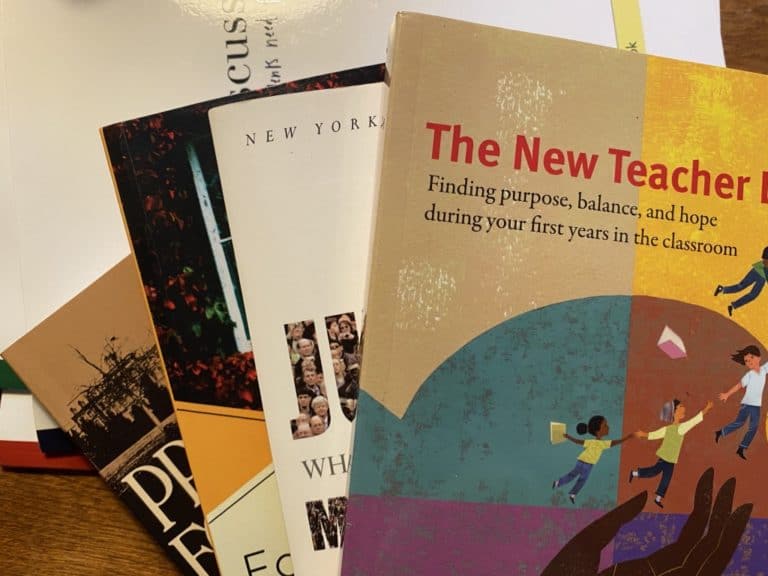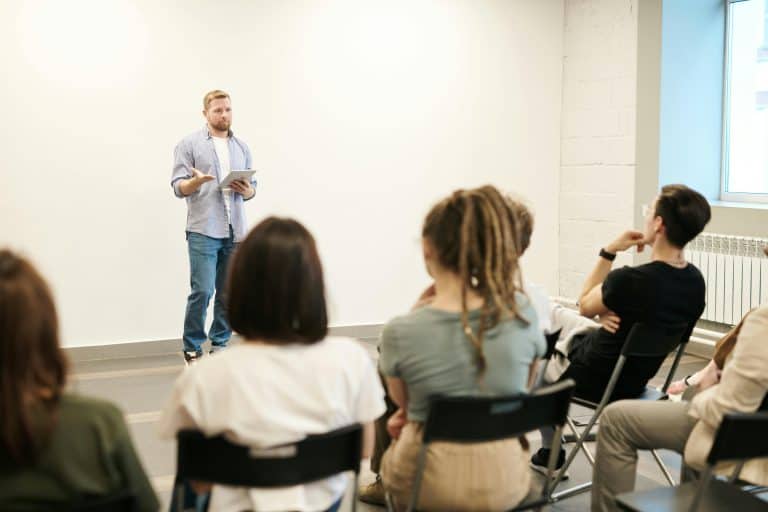Building Self-Efficacy in Math through Discussion: A Conversation with Duncan Flaherty
Duncan Flaherty is a fifth and sixth grade math teacher at Nashoba Brooks School in Concord, MA. This year he is conducting an action research project through a fellowship with the International Coalition of Girls Schools (ICGS) on how using R.E.A.L.® Discussion in math class can be a lever for improving girls’ feelings of self-efficacy. What follows is a conversation between Duncan and R.E.A.L.® Director of Program Emily Gromoll. This conversation has been lightly edited for clarity.
Emily: Welcome Duncan! I’m thrilled to get to talk to you. Let’s start by having you tell us about yourself. Where do you teach, what subject, what grade level?

Duncan: Thank you for having me! I’m very excited to be here discussing R.E.A.L.®, which has been so great in my classroom. I teach at Nashoba Brooks School, which is in Concord, Massachusetts, and our school is all-girls from grades four to eight. I teach math in the fifth and sixth grades. In addition to being a math teacher, which is one of my favorite parts of my life, I’m also a dad. I have three girls, and my wife is also a math teacher, so there is lots of math in our house. I grew up as an avid athlete, and my main sport was downhill skiing in college. We also watch a lot of basketball. My wife played basketball, so family, math, and sports are our big family things.
Emily: That’s so neat. I had no idea that you were a downhill skier! It’ll be great to get your girls on the slopes in the future.
When we talk to practitioners out in the field, we often start with the “why”. What are the reasons you are invested in discussion-based learning? Tell us a little bit about how you came to focus on discussion as a key lever in your students’ math journeys.
Duncan: Absolutely. I think “why” is such an important place to start. I’ve been teaching middle school math for about a decade now, and I really began looking at my teaching practices in the post-COVID landscape in 2021. What I was seeing was that a lot of my students were engaged in outside math programs during that time, and specifically online math learning. I noticed that while their acceleration through some of the algorithm-type processes was getting faster, they were demonstrating what seemed to be less and less conceptual understanding. I saw that their discussion skills, within those conceptual understanding conversations, were lacking, so they were having a hard time centering curiosity.
I saw that their discussion skills…were lacking, so they were having a hard time centering curiosity.
Duncan Flaherty
Also, when they came away from group work, I was seeing a lot of frustration, and my students seemed to think that it would have been easier to do the work by themselves. Working in groups was frustrating and time-consuming, because they didn’t have the conversation skills they needed to come to agreement and consensus. That slowed them down.
I started looking at how to make their thinking visible, and I realized that when everyone’s working on a desk on paper, it makes it difficult to have a conversation about the work they’re doing. I found that having the kids put their work up on whiteboards has been really pivotal in facilitating more math conversations around their written work. So I did that, and I also have been using visibly random groups. And those two things – the whiteboards and the visibly random groups – have done a lot to increase the volume of math discussion.
Emily: For the visibly random learning teams, does that mean you’re setting the expectation that students are going to be in random groups?
Duncan: Exactly. In my class we have four different pod stations, and they’re up on the whiteboards and named after women mathematicians. There is a color, a name and a symbol on each card. At the beginning of class, students stand outside my room and everyone gets a card. The student who gets the Sally Ride card, which is blue and has a “greater than” symbol, is the one that gets to choose if name, symbol or color will determine where everyone will go for the day – into which of the four pod stations.
The research behind this approach is that it removes the expectation that the teacher has engineered the group based on either some social dynamic in the class or math ability. Researchers found that when you do that, students come to the group with a more optimistic view of their participation.
Emily: That’s really interesting!
Alongside this goal of making thinking more visible, you and I have had many conversations about the idea of self-silencing. As you’ve mentioned, this is the idea, especially in an all-girls classroom, that students would choose not to say anything, especially if they don’t understand something, or if they have questions. That self-silencing can really affect math learning in a lot of different ways. Can you share a bit with us about what that looks like and where you think it might come from?
Duncan: Self-silencing is a really significant shaper of the dynamics we see in all-girls math classes. It can be hard to identify at first, because by definition it’s silent and at times invisible. Once you start to look for it, though, I think you’ll begin to realize how common it is – so common that many of our students, if not most, don’t actually realize they’re doing it.
I think we need a mindset shift from a fixed mindset of perfectionism to a growth mindset of curiosity to be able to grapple with math concepts. When we’re silent, it can feel safe, because we can be sure we’re not making a mistake. With girls especially, who receive so many messages about the need to be perfect, silence can feel like a safe choice, especially in a math setting, where you’re not going to get the answer wrong if you don’t say anything.
When we’re silent, it can feel safe, because we can be sure we’re not making a mistake. With girls especially, who receive so many messages about the need to be perfect, silence can feel like a safe choice, especially in a math setting, where you’re not going to get the answer wrong if you don’t say anything.
Duncan Flaherty
One thing I noticed was that I wasn’t hearing from some of the students in my math classes who had really high assessment marks, and I knew from their written work that they had a lot to say. That had an interesting impact on the class as a whole, because when many of your students aren’t speaking, it gives the whole class the illusion that no one else has thoughts or questions.
On a deeper level, I think a lot of what’s going on is that we perceive math as an indicator of who’s smart, and there’s status surrounding intellectual ability. Students are worried that they’re going to sacrifice respect or status if they visibly struggle with the math material. We know that respect is a driving developmental need at the middle school age, so I think we need to be really careful about how we measure understanding in the classroom. It’s really important to stress that good questions actually do show a very deep understanding.
I think we need to be really careful about how we measure understanding in the classroom. It’s really important to stress that good questions actually do show a very deep understanding.”
Duncan Flaherty
Emily: It’s such an important point, because students think if everybody else understands something, then I’ll need to ask somebody later or work through it on my own. There’s a risk in saying something when you feel like if you make a mistake, others will think less of you.
Duncan: Yes, exactly. And also, when you ask kids to raise their hands and volunteer an answer, you’re creating such a stage for that type of competition over the answer.
I think it’s really important for math in general to de-emphasize the performance aspect as much as possible. That’s why my room is mostly covered in whiteboards – it doesn’t feel like a stage, but it feels like a workshop. I think that kind of messaging can help shift the idea of math away from a way to show you’re really smart and toward a challenge and a way to seek understanding – much of which is facilitated through discussion.
My classroom doesn’t feel like a stage, but it feels like a workshop…That kind of messaging can help shift the idea of math away from a way to show you’re really smart and toward a challenge and a way to seek understanding — much of which is facilitated through discussion.
Duncan Flaherty
Emily: That’s a really good point. So tell me a bit about how you see R.E.A.L.® as a tool to address self-silencing. What are the aspects of the framework that have worked most effectively in your math classes?
Duncan: When I first began using R.E.A.L.® this year, I did the orientation materials with our students, and they were really excited about it. We did the drills with the R, the E, the A, the L, they had their non-verbal communication symbols, they were ready to go!
Then I passed out the DQ Prep sheets and the math journal entries that we were going to be analyzing. I saw that some of my students around the room started to look a little nervous. So I asked, “how’s everybody doing with this?” And one of my students raised her hand and said, “I don’t understand the question. I don’t understand how the second method generates prime factors.”
We had been looking at two different methods for doing prime factorization, one that we had a lot of practice with, and one that was mathematically the same, but laid out differently. When she said that, five or six of my other kids nodded their heads, and it really caught on. All of a sudden, I realized, they’re using their skills! Yes! They’re doing the NVCs! After that she looked really relieved, because other people had questions too. So we turned back to the workbooks and started with “A is for Ask”. We talked about how all great discussions start with great questions. I had them write them out what they didn’t understand in the evidence column, then in the editorial column, they wrote specifically about what didn’t make sense. That gave them a lot of comfort, because they realized they could write down what they didn’t understand.
When they asked if they were allowed to have a conversation about not understanding something – “Can I write in my notes that I don’t understand what the question is?” – it really struck me as a very profound breaking of silence.
Through the course of the conversation, they completely co-created mathematically the conceptual understanding for how the first method related to the second, and they did it entirely by themselves. It wasn’t that they didn’t have the tools to get from the first method to the second method – it was that there had been a block that they had been unsure how to navigate.
This is what good discussions do – they help you work through that block. The part I thought was so powerful was that R.E.A.L.® gave them all the vocab and the language they needed to get through the block. They sounded like mathematicians discussing it, and they heard each other sounding like mathematicians. When you find someone who has the same type of question as you, it’s so exciting, right?
It wasn’t that they didn’t have the tools to get from the first method to the second method — it was that there had been a block that they had been unsure how to navigate. That’s what good discussions do — they help you get through that block.
Duncan Flaherty
Emily: And all of a sudden you move from the discomfort of not understanding something to realizing that nobody understands that thing. In this way, the point of the activity is to work through the fact that nobody understands yet, as opposed to getting it right as fast as possible.
Duncan: And to make sure everyone sees that I got it right. It was so powerful for students to show that they have the tools to talk about math like a mathematician – and that in itself shows understanding.
Emily: What a huge shift. That is really cool.
Duncan: One thing I noticed when looking at the survey data is that students might agree that they are strong math students, and they might also agree that strong math students do make mistakes, but they don’t necessarily see that their peers perceive them as mathematicians. When we’re looking at the metrics for self-efficacy, social persuasion, and vicarious experiences, all of which are reflected in the process of having a conversation with peers, building capacity in those areas is really powerful for students. They see themselves having confidence in their competency, which is a really important thing for identity development in math. So, I really can’t say enough about that kind of moment in itself, and what I’ve seen come from that moment. It is really amazing.
Emily: It’s exciting, especially at the beginning of the year. I mean, that was September, right? That conversation sets the stage for the rest of the year!
Switching gears a bit – one question that we get a lot is how to write a good Discussion Question (DQ). I’m curious what a DQ looks like in your math classroom. Walk us through your process of writing DQs for math.
Duncan: Good question! For all the reasons we just discussed, the way you set the stage for conversation matters so much. I try to be responsive to the needs of what I’m seeing. When I’m doing formative assessments, when I’m looking around at the whiteboard work, I try to notice what issues are coming up and try to have my direct teaching voice enter the space as little as possible. Then, I try to write DQs that allow students to co-create knowledge. We call it peer knowledge mobility. Creating mathematical understandings that move through the room really helps them see each other as mathematicians and builds a pretty cool culture in the space.
When writing these questions, I do a little engineering toward the kind of conversation I would love to hear. Some of the reference texts I’ve been using have been completed journal entries. In the first discussion question, I often have students compare and contrast methods mathematically. Then I have the second DQ build on something related to the conceptual understanding they would have built in the first DQ, and that’s worked out pretty well.
Another example is with an order of operations problem with exponents that had a mistake. It was a problem where they were adding two exponents, and the mistake was that the person had added the base number of the exponents, then kept the exponent itself the same. The first DQ was, “What is the mistake here?” Then the second question was, “Why? How could you mathematically prove that?” That generated a lot of really rich talk about multiplication, expressions, exponents, and order of operations. It reminded students of learning the commutative, associative, and distributive properties. You have to draw on past math knowledge, and they made a lot of connections. I wasn’t expecting that one to be cut and dried but they did a really nice job with it.
Another thing I see often is that they won’t say something because they think it’s too obvious. They might notice something, but they think everyone else has probably noticed it. I tell them no – we have to say the things we see out loud.
They love the pass-off system. As they get going they get so excited about talking. And I can tell it gives them a grounded sense that they know there will be a fair system for who goes next.
Emily: Where do you go from here? What will R.E.A.L.® look like for you in the classroom this year, and what do you hope to learn along the way?
Duncan: I’m trying to just stay present with what’s going on in front of me. I’m trying not to have a direction where I want it to go or have a specific outcome that I’m pursuing. The thing I’ve seen that has been really exciting is this potential for scaffolding: how to ask questions and how to ask conceptual questions. I was not expecting that to be such a powerful piece of this, and it kind of threw me off guard a bit that students realized they could ask a question about understanding.
Thank you for the conversation and for all the work you do to equip students with the tools they need to grow, Duncan!






